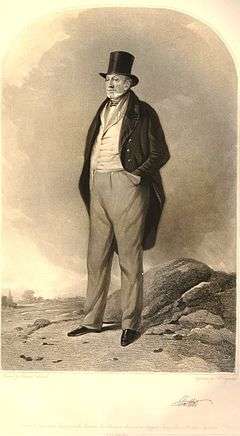Charles Chetwynd-Talbot, 2nd Earl Talbot
| The Right Honourable The Earl Talbot KG KP PC FRS | |
|---|---|
 | |
| Lord Lieutenant of Ireland | |
|
In office 3 October 1817 – 8 December 1821 | |
| Monarch |
George III George IV |
| Prime Minister | The Earl of Liverpool |
| Preceded by | The Earl Whitworth |
| Succeeded by | The Marquess Wellesley |
| Personal details | |
| Born | 25 April 1777 |
| Died |
10 January 1849 (aged 71) Ingestre Hall, Staffordshire |
| Nationality | British |
| Spouse(s) | Frances Lambart (d. 1819) |
| Alma mater | Christ Church, Oxford |
Charles Chetwynd Chetwynd-Talbot, 2nd Earl Talbot KG, PC, FRS (25 April 1777 – 10 January 1849), styled Viscount Ingestre between 1784 and 1793, was a British politician. He served as Lord Lieutenant of Ireland between 1817 and 1821.
Background and education
Born Charles Talbot, he was the eldest son of Hon. John Talbot of Ingestre Hall and his wife, Charlotte, Countess Talbot a daughter of Wills Hill, 1st Marquess of Downshire. When Talbot's father was created Earl Talbot and Viscount Ingestre in 1784, Talbot assumed the latter as a courtesy title. His father also added Chetwynd to the family name in 1786. Talbot inherited his father's earldom and the Ingestre estate in 1793, matriculated from Christ Church, Oxford in 1794 and graduated as a Master of Arts in 1797. He commissioned the architect John Nash to renovate Ingestre c.1810.[1]
Early career
After leaving Oxford, Lord Talbot joined the British embassy in Russia under Lord Whitworth, forming a lasting friendship with his boss. In 1803, Lord Talbot organised a volunteer force in Staffordshire to oppose a planned invasion by Napoleon. In 1812, he was appointed Lord Lieutenant of that county, an office he held until his death. He was elected a Fellow of the Royal Society in 1813.[2]
Lord Lieutenant of Ireland
In 1817, Talbot was also appointed Lord Lieutenant of Ireland and admitted to the Privy Council. In recognition of his rendering services to the agriculture of Ireland, he was awarded the Freedom of Drogheda and during George IV's visit to the country in 1821, he was appointed a Knight of St Patrick. Although an opponent of Catholic emancipation, Daniel O'Connell gave Talbot credit for his impartiality and Lord Cloncurry called him 'an honourable, high-minded gentleman'. However, the growing discontent in Ireland under Talbot's administration, forced the Prime Minister, Lord Liverpool, to have him replaced with Lord Wellesley in December 1821.
Later life
In 1833, Lord Talbot was encouraged to stand for the chancellorship of Oxford University, but withdrew in deference to the Duke of Wellington. In 1839, in recognition of his services as Lord Lieutenant of Staffordshire, Talbot received a testimonial of £1400, which he used to endow a new church at Salt in Staffordshire. A supporter of Robert Peel, he resigned as a Knight of St Patrick in place of being appointed a Knight of the Garter in 1844, on Peel's recommendation. Lord Talbot subsequently supported the repeal of the Corn Laws, being one of the first peers to do so.
Family
Lord Talbot married Frances Thomasine (d. 1819), daughter of Charles Lambart, in 1800. They had eleven surviving children:
- Lady Frances Charlotte (1801–1823), married William Legge, 4th Earl of Dartmouth
- Hon. Charles Thomas, styled Viscount Ingestre (1802–1826)
- Hon. Henry John, later styled Viscount Ingestre, later 3rd Earl Talbot and 18th Earl of Shrewsbury.
- Hon. Arthur (1805–1884), clergyman.
- Hon. John (1806–1852), judge and member of the Canterbury Association. Father of John Gilbert Talbot.[3]
- Lady Cecil Chetwynd (1808–1877), married John Kerr, 7th Marquess of Lothian.
- Hon. (George) Gustavus (1810–1896), clergyman.
- Hon. William Whitworth (1814–1888), clergyman.
- Hon. Gilbert Chetwynd (1816–1896), clergyman.
- Hon. Wellington Patrick Manvers (1817–1898), soldier.
- Hon. Gerald (1819–1885)
Lady Talbot died in December 1819, less than three months after the birth of her youngest child. Lord Talbot died at his home, Ingestre Hall, in January 1849, aged 71, and was succeeded by his eldest surviving son, Henry, who later also inherited the earldom of Shrewsbury from his distant cousin.
In the Red Lion Public House at Brereton, nr Rugeley Staffs, it is written upon the wall that he had the Red Lion rebuilt in 1847.
References
- ↑ "Name: INGESTRE HALL List entry Number: 1242893". English Heritage. Retrieved 11 May 2014.
- ↑ "Fellow Details". Royal Society. Retrieved 11 May 2014.
- ↑ Bain, Rev. Michael (2007). The Canterbury Association (1848–1852): A Study of Its Members' Connections (PDF). Christchurch: Project Canterbury. pp. 79–80. Retrieved 22 September 2012.
- E. I. Carlyle, revised by H. C. G. Matthew. "Talbot, Charles Chetwynd-, second Earl Talbot of Hensol (1777–1849), politician". Oxford Dictionary of National Biography. Retrieved 11 March 2008.
- Cokayne et al., The Complete Peerage
| Political offices | ||
|---|---|---|
| Preceded by The Earl Whitworth |
Lord Lieutenant of Ireland 1817–1821 |
Succeeded by The Marquess Wellesley |
| Honorary titles | ||
| Preceded by The Earl of Uxbridge |
Lord Lieutenant of Staffordshire 1812–1849 |
Succeeded by The Marquess of Anglesey |
| Preceded by The Marquess of Stafford |
Custos Rotulorum of Staffordshire 1828–1849 | |
| Peerage of Great Britain | ||
| Preceded by John Chetwynd-Talbot |
Earl Talbot 1793–1849 |
Succeeded by Henry John Chetwynd-Talbot |